According to recent studies, more than 20 million Americans are addicted to at least one substance. Some of these people may struggle with more than one addiction, known as polysubstance abuse. According to the CDC, more than one drug was present in half of the overdoses in 2019. Learn more about polysubstance abuse, the drugs involved, and how substance abuse affects people’s health and lives.
What is Polysubstance Abuse?
Polysubstance abuse is the abuse of at least two substances. Taking drugs or alcohol in this way can be both intentional and unintentional.
Intentional Polysubstance Abuse
Many addicts use more than one substance. It’s not uncommon, and it is very dangerous. Examples of intentional polysubstance abuse include:
- Using a stimulant like cocaine and then taking benzodiazepines to come down
- Mixing stimulants like methamphetamine and MDMA
- Mixing opioids and benzodiazepines
- Mixing alcohol with anything
Unintentional Polysubstance Abuse
In some cases, using more than one drug happens unintentionally. The drug use could be an accident on the user’s part, or the user may take drugs cut with other substances. For example, accidentally taking a prescription before reading the warning label or using drugs that contain other substances, like fentanyl, are ways to abuse two substances unintentionally.
The Dangers of Polysubstance Abuse
Even outside of a drug abuse scenario, mixing drugs is always risky. Some medications can have dangerous side effects when combined. Your doctor will review your medical history and use that information when prescribing medications to avoid mixing drugs that may result in a reaction.
Medical mix-ups happen, and they are dangerous. However, the most dangerous situations are when someone knowingly combines drugs to increase or decrease an effect.
The Dangers of Mixing Alcohol and Other Drugs
Alcohol is a depressant. It dulls the central nervous system, which causes drowsiness, shallow breathing, and poor decision-making. If another depressant, like opioids or benzos, enters the mix, the results could be deadly. Cardiac or respiratory arrest is common in those who mix alcohol with other downers. Falling unconscious, vomiting, and choking or aspirating on the vomit is a dangerous possibility.
Some people mix alcohol with stimulants. They do this to counter the effects of alcohol and attempt to feel more sober or awake. In many cases, the desired result is not achieved. Stimulants can trick the user into thinking they can drink more than is safe. This mistake can lead to alcohol poisoning. Mixing alcohol with stimulants can also result in heart problems, mood and personality changes, or seizures.
The Dangers of Mixing Opioids and Benzodiazepines
Opioids like Vicodin or Percocet should never be taken with benzodiazepines like Xanax or Valium. They are both depressants, and those depressant qualities are amplified when the drugs are combined.
Symptoms include difficulty breathing, unconsciousness, weakness, and slurred speech. These symptoms indicate a possible overdose and risk of death. More than 30% of opioid overdoses also involve benzodiazepines.
The Dangers of Mixing Stimulants and Other Drugs
Stimulants come in many forms and include prescription medications like Adderall or Ritalin. The illegal forms of stimulants are methamphetamine and cocaine. Stimulants work by increasing your focus and concentration and can also increase heart and breathing rates.
When monitored by a physician, Adderall and Ritalin are safe prescription drugs for people with narcolepsy and attention deficit disorders. When used recreationally, these medications become problematic and even deadly.
Many people take stimulants and try to come down by taking opioids, alcohol, or benzodiazepines. The results can be very dangerous. Since the different drugs send mixed messages to the brain, the situation can become precarious. There is a severe risk of overdose and coma.
The Dangers of Mixing Street Drugs
Fentanyl is a deadly street drug that has risen in popularity and availability in recent years. The DEA has sent warnings to city officials across the United States, explaining of the dangers. Fentanyl is rarely taken by itself, and all too often, users are unaware they’re taking fentanyl at all.
Fentanyl is a synthetic opioid, and illicit drug manufacturers sometimes use less expensive fentanyl to cut other drugs like heroin and cocaine. Consuming fentanyl can cause respiratory problems, vomiting, dizziness, and unconsciousness. Fentanyl can also lead to overdose and death.
How to Help Someone With Polysubstance Abuse?
Polysubstance abuse is dangerous. If someone’s substance abuse has spiraled into mixing drugs, then they’re at risk. It’s time to consider treatment for their drug addiction.
Treatment for Polysubstance Abuse
Using multiple drugs is one of the most dangerous types of abuse. Treating this condition becomes multi-faceted. The healthcare team must address the use of each type of drug and form a plan for withdrawal and treatment.
In most cases, polysubstance abuse requires inpatient treatment. Detox is the first step, and it requires careful monitoring. Physicians might also suggest medication-assisted treatment depending on the case.
Once the patient completes detox, they can move on to counseling and therapy to learn more about their addictions. Twelve-step meetings and specialized therapies are essential components of a successful treatment plan.
Getting Treatment for Polysubstance Abuse
Misusing any drug is dangerous. Misusing more than one drug can quickly become fatal. If you or someone you love is battling polysubstance abuse, the time to get help is now. Our team at Comprehensive Wellness Center has the knowledge, experience, and skills to tackle even the most challenging substance addiction cases. Contact us today to find out how we address polysubstance abuse and help you or your loved one work toward a brighter future.

